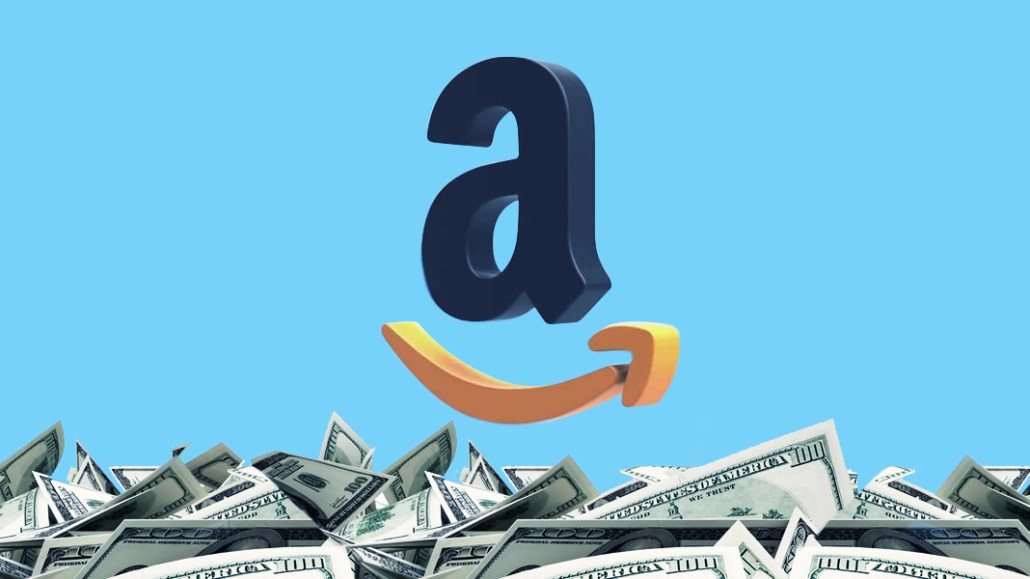
Subscribe to the Digiday Retail Briefing: A weekly email with news, analysis and research covering the modernization of retail and e-commerce.
Get ready for publishers to start grousing about the triopoly.
New forecasting from multiple analysts places Amazon’s still-nascent advertising platform as poised to not only become the third leg of the advertising duopoly of Google and Facebook, but also overtake it.
First up was eMarketer, which said it expected Amazon to be No. 3 in digital ad sales in 2018 with $4.6 billion in ad revenue in the U.S. That would mean that its acceleration in growth in ad revenue is putting it on pace to overtake Oath and Microsoft.
There’s a few things Amazon has done right recently. One is that it is much more effective at monetizing its traffic than others are — even others in retail media. A quick look at Amazon’s own search results page shows how many more ads now appear above the fold than used to.
Amazon’s recent moves to streamline its own business, getting rid of its confusing terminology of Amazon Media Group and Amazon Marketing Services in favor of an “Amazon Advertising” umbrella, is also making it more palatable — not only to agency ad buyers, but an increasing number of direct to consumer brands and those selling directly on Amazon. Another big move, according to eMarketer, has come from Amazon’s own increased push to what it calls non-endemic advertisers like auto companies. The message: Even if you don’t sell on Amazon, you can certainly and effectively advertise on it.
Jefferies this week said that the advertising, as well as subscriptions, is growing two times faster than the core Amazon retail business, with analyst Brent Thill expecting Amazon to hit $1.5 trillion by 2020.
Meanwhile, L2 founder and industry prognosticator Scott Galloway expects Amazon advertising to hit $11 billion this year, which means it will get as much in ad revenue as Instagram, Snapchat and Twitter combined.
That’s what is perhaps most interesting about the Amazon story. In some ways, the under-covered story of the e-commerce boom is the story of media. While Amazon may be the biggest player in the retail media space right now, others are also making moves. Walmart has been out talking to more buyers about its own advertising capabilities, while other retailers, including Kroger, are of increased interest to ad buyers.
“Ignore the cloud, ignore the retail [but] one of the biggest media companies in the world is a retailer,” said Galloway.
Overheard
“Influencers don’t have a conventional design background, but they have a very strong point of view and aesthetic. Not being able to sketch doesn’t mean you’re not a designer.” — A Nordstrom rep, explaining the basis for influencer Arielle Charnas’ new line for the retailer
What we covered
Weight Watchers, which rebranded as WW this week, is building out its mobile app to become a personalized wellness platform that stands on its own, as opposed to an add-on to meetings that take place in person. The app will now feature an Instagram-like community and more ways to track fitness goals.
Shopify is the $17 billion company that has quietly become the plumbing and power behind the direct-to-consumer brand revolution. It’s done it by building a network and ecosystem of apps, vendors and agencies that work within it to help DTC brands — and more — do everything from sales to marketing.
Michael Kors Holdings Limited — now renamed Capri Holdings Limited — plans to build the Versace brand into a $2 billion business. To make this happen, Michael Kors is going to have to focus more on product, double down on luxury and make e-commerce a core focus.
More in Marketing

Lowe’s wants to do more with AI shopping in 2026
Mylow, a shopping assistant powered by ChatGPT that launched in March, is already driving double the conversion rate for online shoppers.

‘This isn’t the old pre-roll world’: YouTube has been talking TV — now it’s selling that way
YouTube is ramping up efforts to get TV’s largest advertisers to move more of their budget into its platform.

As every screen becomes shoppable, attribution problems resurface
As more media environments become points of purchase, attribution and measurement remain the thorn in the side of commerce execs.





